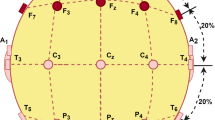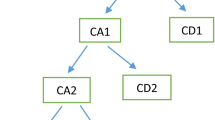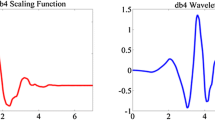Abstract
In this study, a classification is done for electroencephalogram (EEG) and electrocardiogram (ECG) records belong to arithmetic tasks with good and bad performances. Thus, it is aimed to evaluate the differentiation in mental arithmetic activity performance using EEG and ECG signals. First of all, EEG signals, taken from 36 subjects and labeled as good and bad performance according to the number of procedures performed within the same period, are divided into sections of 10 s. Sub-components are obtained using wavelet transform for segmented electroencephalogram and electrocardiogram recordings. The feature set is created by calculating the energy of the wavelet components from electroencephalogram recordings belong to 19 channels. The obtained feature set is classified by using logistic regression, support vector machines (SVM), linear discriminant analysis, and k-nearest neighborhood (k-NN) methods. The feature extraction process is repeated for electrocardiogram signals recorded during the arithmetic mental task, resulting in an extended feature set. The classification process in the expanded space is repeated using the same features. As a result of the analysis, it is observed that wavelet-based features are effective in determining mental activity performance. High accuracy classification is done by k-NN and SVM, respectively. For only EEG signals, the best classification result is obtained with k-NN with 97.22% accuracy, and for EEG and ECG signals are used together, the best result is obtained with k-NN with 99% accuracy. Features extracted from ECG signals have increased classification accuracy.






Similar content being viewed by others
Data availability
The data used in the study is open access. Data are taken from the PhysioNet database.
References
Mathur P, Chakka VK (2022) Graph signal processing based cross-subject mental task classification using multi-channel EEG signals. IEEE Sens J 22(8):7971–7978
Leuthardt EC, Schalk G, Wolpaw JR, Ojemann JG, Moran DW (2004) A brain–computer interface using electrocorticographic signals in humans. J Neural Eng 1(2):63
Krepki R, Curio G, Blankertz B, Müller KR (2007) Berlin brain–computer interface—The HCI communication channel for discovery. Int J Hum Comput Stud 65(5):460–477
Übeyli ED (2009) Combined neural network model employing wavelet coefficients for EEG signals classification. Digital Signal Process 19(2):297–308
Amin HU, Malik AS, Ahmad RF, Badruddin N, Kamel N, Hussain M, Chooi WT (2015) Feature extraction and classification for EEG signals using wavelet transform and machine learning techniques. Australas Phys Eng Sci Med 38(1):139–149
Zarjam P, Epps J, Lovell NH (2012) Characterizing mental load in an arithmetic task using entropy-based features. In: 2012 11th International Conference on Information Science, Signal Processing and their Applications (ISSPA. IEEE, pp. 199–204
Nai-Jen H, Palaniappan R (2004) Classification of mental tasks using fixed and adaptive autoregressive models of EEG signals. In: The 26th Annual International Conference of the IEEE Engineering in Medicine and Biology Society vol 1. IEEE, pp. 507–510
Liang NY, Saratchandran P, Huang GB, Sundararajan N (2006) Classification of mental tasks from EEG signals using extreme learning machine. Int J Neural Syst 16(01):29–38
Turner JR, Sims J, Carroll D, Morgan RK, Hewitt JK (1987) A comparative evaluation of heart rate reactivity during MATH and a standard mental arithmetic task. Int J Psychophysiol 5(4):301–303
KutluOnay F, Köse C (2017) Classification of functional near-infrared imaging based hemodynamic patterns recorded at mental arithmetic and resting. Eng Sci (NWSAENS) 13(1):27–36
Wen Y, Qi X, Cui S, Chen C, Chen M, Zhao J, Wang G (2019) A multi-channel NIRS system for prefrontal mental task classification employing deep forest algorithm. In: 2019 IEEE Biomedical Circuits and Systems Conference (BioCAS), pp 1–4
Palaniappan R (2005) Brain computer interface design using band powers extracted during mental tasks. In: Conference Proceedings. 2nd International IEEE EMBS Conference on Neural Engineering, pp 321–324
Yu X, Zhang J, Xie D, Wang J, Zhang C (2009) Relationship between scalp potential and autonomic nervous activity during a mental arithmetic task. Auton Neurosci 146(1–2):81–86
Wang Q, Sourina O (2013) Real-time mental arithmetic task recognition from EEG signals. IEEE Trans Neural Syst Rehabil Eng 21(2):225–232
Ergün E, Aydemir O (2020) A new evolutionary preprocessing approach for classification of mental arithmetic based EEG signals. Cogn Neurodyn 14(5):609–617
Yu J, Liu GY, Wen WH, Chen CW (2020) Evaluating cognitive task result through heart rate pattern analysis. Healthcare Technol Lett 7(2):41–44
Rahman MM, Chowdhury MA, Fattah SA (2018) An efficient scheme for mental task classification utilizing reflection coefficients obtained from autocorrelation function of EEG signal. Brain informatics 5(1):1–12
Gupta A, Agrawal RK, Kirar JS, Andreu-Perez J, Ding WP, Lin CT, Prasad M (2019) On the utility of power spectral techniques with feature selection techniques for effective mental task classification in noninvasive BCI. IEEE Trans Syst Man Cybern Syst 51(5):3080–3092
Hekmatmanesh A, Wu H, Motie-Nasrabadi A, Li M, Handroos H (2019) Combination of discrete wavelet packet transform with detrended fluctuation analysis using customized mother wavelet with the aim of an imagery-motor control interface for an exoskeleton. Multimedia Tools Appl 78:30503–30522
Siviero I, Brusini L, Menegaz G, Storti SF (2022) Motor-imagery EEG signal decoding using multichannel-empirical wavelet transform for brain computer interfaces. In: 2022 IEEE-EMBS International Conference on Biomedical and Health Informatics (BHI), IEEE, pp. 1–4
Zyma I, Tukaev S, Seleznov I, Kiyono K, Popov A, Chernykh M, Shpenkov O (2019) Electroencephalograms during mental arithmetic task performance. Data 4(1):14
Graps A (1995) An introduction to wavelets. IEEE Comput Sci Eng 2(2):50–61
Mallat SG (1989) A theory for multiresolution signal decomposition: the wavelet representation. IEEE Trans Pattern Anal Mach Intell 11(7):674–693
Ocak H (2009) Automatic detection of epileptic seizures in EEG using discrete wavelet transform and approximate entropy. Expert Syst Appl 36(2):2027–2036
Kehtarnavaz N, Kim N (2011) Digital signal processing system-level design using LabVIEW. Elsevier
Dehbozorgi L, Farokhi F (2010) Notice of Retraction: effective feature selection for short-term earthquake prediction using neuro-fuzzy classifier. In: 2010 Second IITA International Conference on Geoscience and Remote Sensing vol 2. IEEE, pp. 165–169
Bramer M (2007) Principles of data mining, vol 180. Springer, London
Kubat M (2017) An introduction to machine learning. Springer International Publishing AG, Cham. https://doi.org/10.1007/978-3-319-63913-0
Press SJ, Wilson S (1978) Choosing between logistic regression and discriminant analysis. J Am Stat Assoc 73(364):699–705
Bishop CM (2006) Pattern recognition and machine learning. Springer, NY
Fielding AH (2006) Cluster and classification techniques for the biosciences. Cambridge University Press
Michie D, Spiegelhalter DJ, Taylor CC (1994) Machine learning. Neural Stat Classif 13(1994):1–298
Funding
The authors did not receive support from any organization for the submitted work.
Author information
Authors and Affiliations
Contributions
EB contributed to conceptualization, methodology, software, and validation. CO contributed to conceptualization, visualization, and investigation. EUE contributed to writing—original draft preparation, writing—reviewing and editing, and investigation.
Corresponding author
Ethics declarations
Conflict of interest
The authors declare that they have no conflict of interest.
Additional information
Publisher's Note
Springer Nature remains neutral with regard to jurisdictional claims in published maps and institutional affiliations.
Rights and permissions
Springer Nature or its licensor (e.g. a society or other partner) holds exclusive rights to this article under a publishing agreement with the author(s) or other rightsholder(s); author self-archiving of the accepted manuscript version of this article is solely governed by the terms of such publishing agreement and applicable law.
About this article
Cite this article
Bergil, E., Oral, C. & Ergül, E.U. Classification of arithmetic mental task performances using EEG and ECG signals. J Supercomput 79, 15535–15547 (2023). https://doi.org/10.1007/s11227-023-05294-0
Accepted:
Published:
Issue Date:
DOI: https://doi.org/10.1007/s11227-023-05294-0




